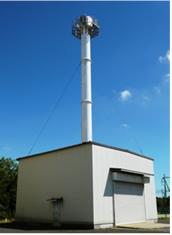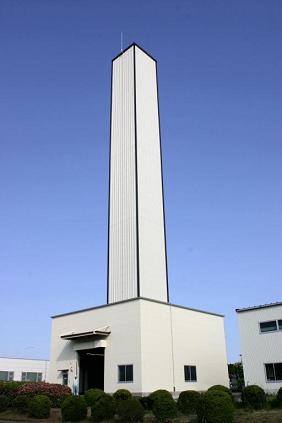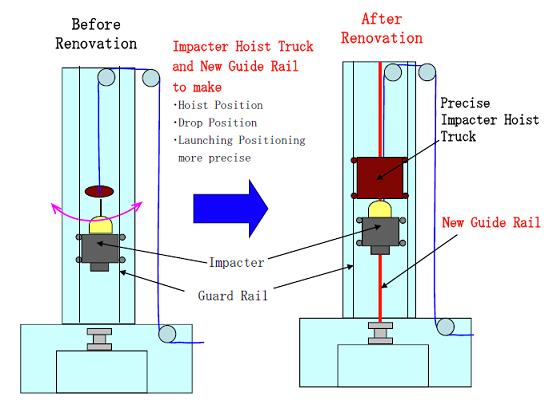Sumitomo Metals Develops High-Precision Drop Weight Impact Test Machine
― For Collision Safety Enhancement ―
2010.10.20
- Sumitomo Metal Industries, Ltd.
In 2002, Sumitomo Metal Industries, Ltd. (Sumitomo Metals) developed a Drop Weight Impact Test Machine with the highest speed in Japan at that time, for evaluation of the collision safety performance of automobiles. Since then, we have accumulated test data and contributed to the improvement of automobiles’ collision safety performance. Recently, we have developed an upgraded machine with higher precision. We use this machine to accumulate data and develop technology aimed at further enhancing automobile safety.
1. Development background
In developing automobiles, combination of two performances is important: weight reduction of the vehicle body and the collision safety performance. When Sumitomo Metals develops materials that can reduce weight of automobiles, it is also requested to evaluate the collision safety performance of components made of those materials and make specific proposals on manufacturing processes and the forms of those components.
Sumitomo Metals began the development of a drop weight test in 2001 and became the pioneer that launched No.1 Test Machine in 2002, thereby establishing testing and evaluation technology for components. A drop weight test machine drops an impacter on a test sample in order to evaluate its mechanism or performance related to the absorption of collision energy. Compared to general collision testing, this machine enables more precise control of collision strength and angles.
We developed No.2 Drop Weight Impact Test Machine for testing and evaluating not only components but also automotive body frames and structures in 2005. We also began testing of actual vehicles. We have established testing technology to recreate diverse collision patterns, such as frontal or lateral collisions, at 96 kilometers or 60 miles per hour.
In recent years, vehicle collision safety regulations have become more diverse and complex, with the aim of reflecting the actual conditions of accidents more precisely. For example, criteria have now been established for collisions from the left, right, upper, lower and oblique directions, in addition to frontal collisions. The drop weight test has been required to respond to this change by expanding the range of options for testing and evaluating complex collision conditions relating to automotive bodies and components. The ultimate target for the machine is to enable robust performance in collisions from any direction.
2. Details of development (see Figure 2)
Sumitomo Metals’ No.1 Drop Weight Impact Test Machine hoists an impacter by a wire from the top of the test tower with an electromagnet and drops it. There was a problem with the impacter’s launching position because the electromagnet slightly swung like a pendulum.
No.1 Test Machine incorporated improvements in the electromagnet part and made the impacter’s launching position more precise. The wire that hangs down from the top of the tower is no longer connected to an electromagnet, but rather an impacter hoist truck, while the electromagnet is attached to the bottom of the truck. In addition, a high-precision guide rail has been newly installed on the side wall of the test tower in order to control the positioning of the hoist truck. These changes have stabilized the positioning of the electromagnet and the impacter and prevented fluctuation in the impacter’s launching positioning.
This has also enabled the impacter to always fall squarely and accurately. In addition, tests to apply loading on samples precisely at a certain angle has become possible in two ways: one is to locate the sample in a tilting position at the required angle; the other is to form an impacter with its bottom shaped with a tilt at the required angle.
3. Future development
In Japan, Europe, and the United States, evaluation results concerning automobile collision safety have been published and influenced customers’ purchasing activities. Going forward, similar regulations are expected to be established or enhanced in growth markets such as China, India, and Brazil.
Sumitomo Metals has tested over 5,000 samples since the launch of its No.1 Drop Weight Iimpact Test Machine and has accumulated knowledge and know-how regarding tests and collisions. Based on such accumulated data, we are performing joint tests, with regard to component development and weight reduction, with automobile companies or component companies. We are also helping to enhance the precision of Computer Aided Engineering (CAE*) at automobile makers, improve the body design method, and reduce the weight of components.
By conducting tests and evaluation with high-precision equipment and identifying design-related issues, optimal design of components, with due consideration to materials, manufacturing processes, and shapes, will be easily achieved. Thanks to the use of No.1 Drop Weight Impact Test Machine, we will contribute to the development of components that display superior robust performance.
<Figure 1: Drop Weight Impact Test Machines>
 |
 |
|
No.1 Machine |
No.2 Machine |
<Figure 2: First Drop Weight Impact Test Machine (Before and After Renovation)>
 |
| Note(*) | Computer Aided Engineering (CAE) is to use computer simulation to check design, manufacturing, and process design of products in advance. |
